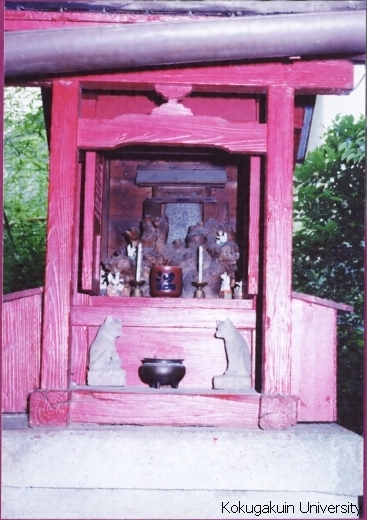- トップ
- Encyclopedia of Shinto
- Yashikigami
Encyclopedia of Shinto
| Main Menu: | |
| Links: |
詳細表示 (Complete Article)
| カテゴリー1: | 2. Kami (Deities) |
|---|---|
| カテゴリー2: | Kami in Folk Religion |
| Title | Yashikigami |
| Text | "Estate kami," a tutelary kami enshrined on or nearby the plot of land on which a human dwelling is built. Most yashikigami are found in the form of small shrines made of wood or stone, or a makeshift straw shrine which may be rebuilt at the time of each regular observance of worship. In other cases, the kami's presence may be indicated merely by a cairn of rocks, or a tree or natural stone may be used to represent the kami's temporary dwelling or manifestation (yorishiro). Since the term yashikigami is an academic expression used to refer generally to any "tutelary kami of the dwelling," the actual terms used to refer to such shrines and their kami vary widely from place to place; some include ujigami, uchigami, jigami, and jinushigami. In some cases, the shrines may be referred to by the proper name of the actual kami worshiped, such as Inari, Shinmei, Gion, Kumano, Hakusan, Tenjin, Tenn?, Hachiman, and Wakamiya. Yashikigami cults can be classified in three main types: first, the type in which the kami is enshrined and worshiped on the property of each individual household; second, the type in which the kami is enshrined only by especially old families representing the main or "stem" families (honke) of patrilineal descent groups (d?zokudan); and third, the type in which the kami is enshrined at the dwelling of a stem family, but participation in its worship is extended to collateral families of the d?zokudan as well. While the third type is thought the oldest, it is believed that the weakening of the structure of the old d?zokudan groups and growing independence of branch families led to proliferation of the second type. In turn, as branch famlies rose in affluence, they also gained autonomy as independent units of village membership, thus leading to the enshrinement of yashikigami by each individual household (the first type). The individual household enshrinement type also arose against the background of a popularized interpretation of the yashikigami as tutelary of individual family and home, and the teachings of mountain ascetics (Yamabushi) and other folk-religious practitioners to the effect that the yashikigami should be propitiated to prevent or eliminate curses on the family. While progressing toward increasing differentiation as noted above, yashikigami cults have also frequently displayed contrary trends toward greater inclusivity as the comprehensive tutelaries of broader geographical areas. This expansion has occurred as shrines of the first and second types became the core of extended cults involving the participation of a wider range of votaries, including individuals outside the kinship group itself. Worship of the yashikigami is generally observed twice annually, in spring and fall, precisely correlating with the interchange widely observed between the ta no kami (kami of the rice paddy) and yama no kami (kami of the mountain), thus suggesting a linkage between the yashikigami and other agricultural tutelaries. Further, occasional cases are seen in which the original pioneer cultivators of a locale, or the spirit of the earliest ancestor (sorei) is enshrined as a yashikigami, and if one accepts that the yama no kami and ta no kami are variations based on the ancestral spirit, one can posit a close relationship between yashikigami and ancestral spirit as well. See also teinaisha. -Iwai Hiroshi |






